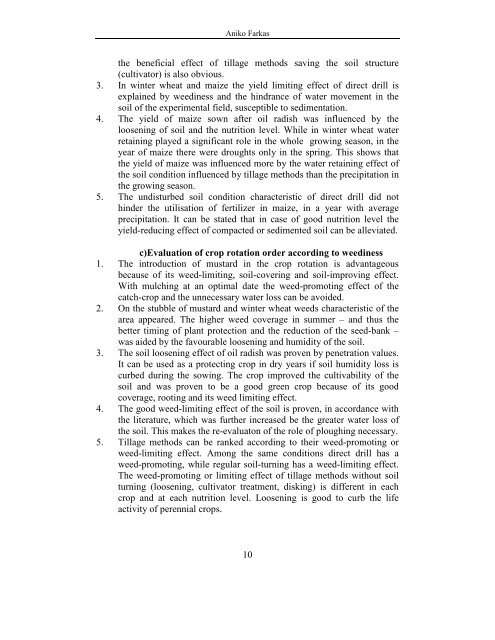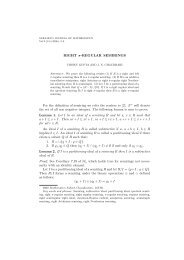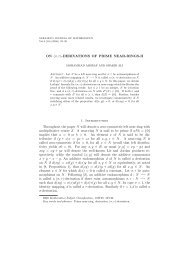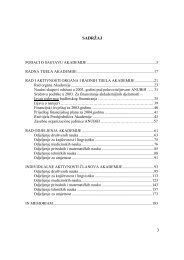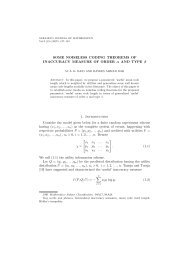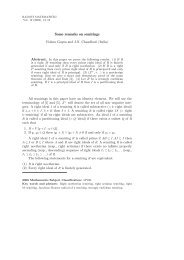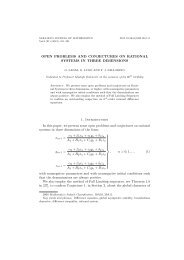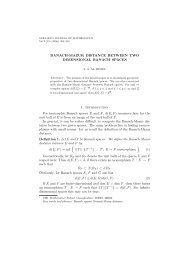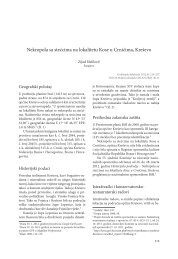HERBOLOGIA - anubih
HERBOLOGIA - anubih
HERBOLOGIA - anubih
Create successful ePaper yourself
Turn your PDF publications into a flip-book with our unique Google optimized e-Paper software.
Aniko Farkas<br />
the beneficial effect of tillage methods saving the soil structure<br />
(cultivator) is also obvious.<br />
3. In winter wheat and maize the yield limiting effect of direct drill is<br />
explained by weediness and the hindrance of water movement in the<br />
soil of the experimental field, susceptible to sedimentation.<br />
4. The yield of maize sown after oil radish was influenced by the<br />
loosening of soil and the nutrition level. While in winter wheat water<br />
retaining played a significant role in the whole growing season, in the<br />
year of maize there were droughts only in the spring. This shows that<br />
the yield of maize was influenced more by the water retaining effect of<br />
the soil condition influenced by tillage methods than the precipitation in<br />
the growing season.<br />
5. The undisturbed soil condition characteristic of direct drill did not<br />
hinder the utilisation of fertilizer in maize, in a year with average<br />
precipitation. It can be stated that in case of good nutrition level the<br />
yield-reducing effect of compacted or sedimented soil can be alleviated.<br />
c)Evaluation of crop rotation order according to weediness<br />
1. The introduction of mustard in the crop rotation is advantageous<br />
because of its weed-limiting, soil-covering and soil-improving effect.<br />
With mulching at an optimal date the weed-promoting effect of the<br />
catch-crop and the unnecessary water loss can be avoided.<br />
2. On the stubble of mustard and winter wheat weeds characteristic of the<br />
area appeared. The higher weed coverage in summer – and thus the<br />
better timing of plant protection and the reduction of the seed-bank –<br />
was aided by the favourable loosening and humidity of the soil.<br />
3. The soil loosening effect of oil radish was proven by penetration values.<br />
It can be used as a protecting crop in dry years if soil humidity loss is<br />
curbed during the sowing. The crop improved the cultivability of the<br />
soil and was proven to be a good green crop because of its good<br />
coverage, rooting and its weed limiting effect.<br />
4. The good weed-limiting effect of the soil is proven, in accordance with<br />
the literature, which was further increased be the greater water loss of<br />
the soil. This makes the re-evaluaton of the role of ploughing necessary.<br />
5. Tillage methods can be ranked according to their weed-promoting or<br />
weed-limiting effect. Among the same conditions direct drill has a<br />
weed-promoting, while regular soil-turning has a weed-limiting effect.<br />
The weed-promoting or limiting effect of tillage methods without soil<br />
turning (loosening, cultivator treatment, disking) is different in each<br />
crop and at each nutrition level. Loosening is good to curb the life<br />
activity of perennial crops.<br />
10


